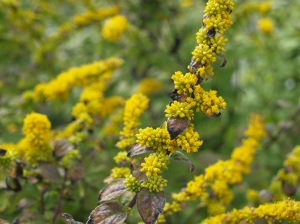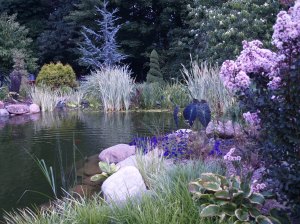The Garden Guru is an occasional series featuring seasonal questions selected through a rigorous, time honored journalistic tradition in which the Guru makes up the questions, then answers them. If you wish to ask your own questions, feel free to submit them and the Guru will pick the ones he knows and include them in the next addition of “Ask the Garden Guru”.
Do I need to mulch my garden this Fall?
Perhaps, but better to err on the side of too little rather than too much. A good part of my business is selling and installing mulch, but I also see the damage caused by too much. Adrian Higgins wrote a fine piece in the Home section of the Washington Post the other day about mulch volcanoes (click to view) and the dangers of excess mulch.
 If there is still a covering of mulch, unless it’s down to bare ground, don’t add more. I’m not a fan of adding more to freshen up the color because mulch loses its color rapidly, so unless you’re mulching for a party or to sell the house this week, mulching to get back the dark color isn’t a good value. You can achieve a measure of result by raking the mulch to turn over the sun faded pieces, but again the color doesn’t last long.
If there is still a covering of mulch, unless it’s down to bare ground, don’t add more. I’m not a fan of adding more to freshen up the color because mulch loses its color rapidly, so unless you’re mulching for a party or to sell the house this week, mulching to get back the dark color isn’t a good value. You can achieve a measure of result by raking the mulch to turn over the sun faded pieces, but again the color doesn’t last long.
If you decide to add mulch I would never recommend a covering of more than two inches, unless you are mulching a tender plant for the Winter to protect its roots. If mulch is too thick it might shed water instead of preserving it, and there is a real possibility of mulching against trunks and stems that can be injured, and of roots growing up into the mulch. Also, some plants, such as azaleas and rhododendrons, prefer to have only a slight covering over their root, and even established plants can die when beds are remulched.
Why do the weeds on the side of the road look better than my garden?
 Weeds are well adapted to their environment. Often, the plants in our gardens are less so. This is not a native, non-native issue. Plants that survive in miserable conditions, thin soils, gravel and road construction debris, are suited to that situation. Many will make poor garden plants, poor foliage, short lived blooms, or they will seed prolifically.
Weeds are well adapted to their environment. Often, the plants in our gardens are less so. This is not a native, non-native issue. Plants that survive in miserable conditions, thin soils, gravel and road construction debris, are suited to that situation. Many will make poor garden plants, poor foliage, short lived blooms, or they will seed prolifically.
Also, roadside weeds seldom have gardeners tinkering about, moving them here and there for better effect, mulching and spraying, and applying composts and fertilizers and whatnot to improve blooms. Plants are usually best served by planting and getting out of the way.
What is a fool’s paradise?
 My garden, your garden, any that is expected to perform without a series of annual and regular tragedies. Plants will get bugs, there will be droughts and floods, the hound or the kids will tumble through coneflowers, and …… well I’m sure you get the idea. Any expectation otherwise is foolish. The gardener must learn to enjoy the successes, large and small, accept the inevitable failures, and move on.
My garden, your garden, any that is expected to perform without a series of annual and regular tragedies. Plants will get bugs, there will be droughts and floods, the hound or the kids will tumble through coneflowers, and …… well I’m sure you get the idea. Any expectation otherwise is foolish. The gardener must learn to enjoy the successes, large and small, accept the inevitable failures, and move on.
What is a sustainable garden?
 What it is, and what some try to make it are different. To a large extent “sustainable” has become an argument for native plants, when there are plenty of non-natives that are adaptable to our conditions without care, and without spreading themselves about and forcing the native vegetation out.
What it is, and what some try to make it are different. To a large extent “sustainable” has become an argument for native plants, when there are plenty of non-natives that are adaptable to our conditions without care, and without spreading themselves about and forcing the native vegetation out.
Sustainable gardening should make sense to all, to create a garden without the need for excess watering, without the need for chemical fertilizers and pesticides, a garden that is long lived and impacts the natural environment in a positive manner. The nature of gardening should demand that we are responsive to these ideals.
If I start a garden will I live longer?
Very likely yes, but your back and knees will ache so that somedays you’ll wish you hadn’t.
Hi,
I live in Illinois and have a 6 year old Eastern Redbud tree which has been growing consistently and doing very well until this Spring when it barely produced any flowers and then had many branches that never produced leaves. I finally found some white sticky looking stuff on one limb and some bronze/brown looking spots on a coupe of other branches. Is it diseased? Is there anything I can do to save it? I appreciate ANY advice I can get! Thanks!
Lisa,
The spots you refer to sound like Scale. Here is a link that explains the problem and solution http://www.ct.gov/caes/cwp/view.asp?a=2823&q=377912.
The treatment should be fairly simple with a sprayer that can reach all affected branches, and then the tree should be fine. I have never had a problem with redbuds in my garden, except for a twenty year old Forest Pansy that is suffering as large maples encroach on its space with deep shade. Every year it loses a few more branches, but this problem was created by where I planted it, not a problem with the tree.
Hi Dave,
I recently moved to a house with 1.5 acres from a townhouse – so I have lots of room for my small potted plant collection. I have a potted hydrangea (the standard blue kind) that I’ve had for maybe 5 years. During our move, it stayed with a friend and was a bit neglected (not watered, lots of dead leaves, etc.) It is recovering nicely, and I’m hoping to give it a much-earned permanent spot in the garden. Should I attempt a transplant this fall, or should I let it recover a bit longer and plant in the spring? Or should I just leave it in the pot? Thanks very much!
Lacy
Yes and no. Yes, the early Fall is ideal to transplant, and the hydrangea will likely be happier in the ground than in a pot. No, because older varieties of mophead hydrangeas have already set flower buds for next year, and Winter temperatures often injure the non-woody branches and buds, so you would be more likely to see flowers if it remained indoors.
In regions of the country that experience Winter temperatures in the teens and lower the older blue hydrangeas are sporadic bloomers because they flower only on old growth, so when that is injured the buds are destroyed. More recent introductions, notably Endless Summer and Penny Mac, bloom on old and new wood, so when they suffer Winter dieback they will still bloom on buds that develop on Spring growth.
This past Winter we had temperature fluctuations that killed several of my three or four foot tall hydrangeas to the ground. Growth in the Spring was rapid, and they bloomed just slightly later than normal. Older, non remontant types, would have had lush foliage, but no blooms this year.
Hello Dave, This is my first time browsing your website. It is so full of information and the pics are awesome. I live in Ashburn Va and have recently had my backyard landscaped by Meadows Farms the designer who assisted in this transition was Glen…whoops I cannot remember his last name. He was excellent as were the crew that made it all happen. I am a gardener with many non hardy plants that I bring in over the winter. I usually distribute them through out the house. Is there a way to designate an area ie basement where I can create a green house llike effect. What kind of lighting would I need? Is there a book or website I could refer to? Finnally I have a very old passion flower which I would like to cut back and was wondering if he could tolerate it. Sorry for this ramble look forward to your reply. Thank You, Nancy Cross
I’m happy to hear that my experiences can be useful, if nothing else for what not to do. The Glenn you mention is Glenn Louis.
I have way too many tropicals this year to fit in the living areas where there is adequate light unless we abandon a room or two. Even then I’m told by my wife that the elephant ears accumulate room humdity on their large leaves and drip on the hardwood floors, so there’s no way I can afford a drip pan six feet wide, and I’m not going to ruin the floors.
So, the elephant ears, a few bananas, cannas, and others that won’t fit are going in the dank, dark, cool basement. Whenever I do this some survive, some don’t, I’m certain because I usually forget about tha occasional water they need. The secret, as I understand it, is to position them in a cool room regardless of a source of light. Plants must be allowed to dry nearly to the point of death, and then watered sparingly to barely keep them alive.
Light and humidty are not important. Apparently, tropicals respond to dry conditions in their native habitat by going dormant. That is what we’re trying to duplicate. You could grow them in the basement with grow lights, but that’s a lot of grow lights for a large plant.
My original inspiration for growing far too many tropicals and hauling them in and out was the famed Washington Post garden writer Henry Mitchell from a couple decades ago. His wonderful collections of garden articles are available in three books.
For more information on overwintering tropicals and for information about specific varieties I recommend the book “Hot Plants for Cool Climates: Gardening with Tropical Plants in Temperate Zones” by Dennis Schrader. I’ve found that it gives valuable tips, and I’ve added new plants from his recommendations. Another book “Palms Won’t Grow Here and other myths: warm-climate plants for cooler areas” by David A. Francko is another with good information. Both are available from Amazon and probably lots of other places.
I’m sorry that I forgot to address your question about the passion flower. They are weeds, indestructible weeds, so mutilation does not deter them one bit. The more it is cut, the faster it will return the next growing season.
I was steadfast in my decision to leave my passion flower vine in a container, which I presumed would enable me to keep it better under control. As often happens, I changed my mind and planted it in late August, next to a contorted dwarf cypress that I treasure. Inevitably, disaster will ensue.